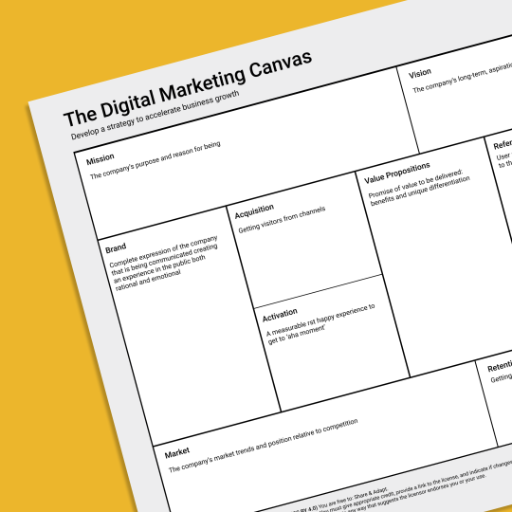Value Proposition Canvas-value proposition creation tool
AI-powered Value Proposition Creation
Help me formulate a value proposition for my product.
Get started.
How do I create a stand out value proposition?
Could you guide me in drafting a concise value proposition?
Related Tools
Load More
Business Model Canvas Strategist
Business Model Canvas Creator - Build and evaluate your business model

GPT Lean Canvas
I guide in creating lean canvases, with a final visual via Zapier on Miro.

Innovator's Lens - for innovation business ideas
Shifting biases for new ideas. Enter "industry", "topic", and "additional information" 「業界」「トピック」「補足情報」を入力すると、そのテーマ内のバイアスを指摘し、ずらしたアイデアを創出します。

Business Model Canvas Builder
A friendly robot specializing in Business Model Canvas.

Value Proposition Composer
Value propositions followed by Osterwalder

The Digital Marketing Canvas (DMC)
A practical guide to develop a strategy to accelerate business growth. The DMC is a tool for Design Thinking. Start by describing your project in 1 or 2 lines.
20.0 / 5 (200 votes)
Introduction to Value Proposition Canvas
The Value Proposition Canvas is a strategic management tool used to design, test, and iterate a company’s product or service offering in alignment with the customer's needs and desires. Created by Alexander Osterwalder, it is a crucial component of the Business Model Canvas. The design purpose is to help businesses ensure that there is a fit between the product they create and the market needs. The canvas is divided into two main sections: the Customer Profile and the Value Map. The Customer Profile includes customer jobs, pains, and gains, while the Value Map details the products and services, pain relievers, and gain creators. By mapping out these elements, businesses can identify the most critical value propositions that will appeal to their target customers. Example: A company developing a new fitness app would use the Value Proposition Canvas to identify the key motivations, frustrations, and desired outcomes of their target users. They might discover that their audience values personalized workout plans (gain), is frustrated by generic fitness advice (pain), and wants to achieve specific fitness goals (job). By addressing these points, the company can tailor its app to better meet the needs of its users.

Main Functions of Value Proposition Canvas
Identifying Customer Jobs
Example
A healthcare startup uses the canvas to understand the different jobs their customers need to get done, such as booking appointments, tracking health metrics, or accessing medical advice.
Scenario
In this scenario, the startup maps out all the tasks their customers need to complete in managing their health. This insight helps them develop a comprehensive app that covers all necessary functions, ensuring higher customer satisfaction and engagement.
Mapping Customer Pains and Gains
Example
An e-commerce platform uses the canvas to identify customer pains such as long delivery times and desired gains like exclusive discounts.
Scenario
By understanding these aspects, the e-commerce platform can develop solutions such as faster shipping options and a loyalty program that offers special deals, thereby directly addressing customer pain points and enhancing the user experience.
Designing Value Propositions
Example
A SaaS company uses the canvas to craft a value proposition that highlights their unique features like advanced analytics and superior customer support.
Scenario
In this scenario, the company identifies what makes their software stand out and communicates these benefits clearly to their target audience, thereby differentiating themselves from competitors and attracting more customers.
Ideal Users of Value Proposition Canvas
Startups and Entrepreneurs
These users benefit from the Value Proposition Canvas by being able to clearly define their product-market fit. Startups often operate with limited resources and need to ensure their offerings resonate with their target audience. The canvas helps them systematically identify and address customer needs, pains, and gains, leading to more targeted and effective product development.
Product Managers and Marketers
Product managers and marketers use the Value Proposition Canvas to refine and optimize their product offerings. By understanding customer profiles in detail, they can tailor their marketing messages and product features to better meet customer expectations. This targeted approach helps in improving customer acquisition and retention rates.

Steps to Use Value Proposition Canvas
Visit aichatonline.org
Visit aichatonline.org for a free trial without login, also no need for ChatGPT Plus.
Identify Your Customer Segments
Clearly define the different customer segments your business is targeting. This helps in creating specific and relevant value propositions.
Map Customer Jobs, Pains, and Gains
Identify the jobs your customers need to get done, the pains they experience, and the gains they expect. This provides insight into their needs and preferences.
Align Your Products and Services
Map how your products and services alleviate pains and create gains for your customers. This alignment is crucial for crafting a compelling value proposition.
Iterate and Validate
Continuously iterate on your value proposition based on feedback and validation. Ensure it remains relevant and impactful to your target audience.
Try other advanced and practical GPTs
JavaScript expert
Optimize Your JavaScript with AI

Cold Email Writer: 2.0
AI-Powered Cold Email Creation

MaltiGPT
AI-Powered Maltese Language Expertise

SSCI Q1 Guidence
AI-powered support for SSCI Q1 journal success.

Circuit Wizard
AI-Powered Digital Circuit Design

Pro Code
Your Ultimate AI Coding Companion

AI and Genealogy Research GPT
AI-powered insights for your ancestry.

Urdu to English Converter
AI-powered Roman Urdu Translation

Academic Reference Finder GPT
AI-powered academic reference generator.

Dynamic Expert
Empower Your Expertise with AI.

PDF Translate and Saver
AI-Powered PDF Translation and Saving

Boxing
AI-powered Boxing Training for All

- Marketing Strategy
- Business Planning
- Product Design
- Customer Research
- Value Analysis
Common Questions about Value Proposition Canvas
What is the Value Proposition Canvas?
The Value Proposition Canvas is a tool that helps businesses create products and services that perfectly match the needs and desires of their customers. It focuses on understanding customer segments and aligning product offerings with customer jobs, pains, and gains.
How can the Value Proposition Canvas benefit my business?
Using the Value Proposition Canvas helps your business to clearly understand and articulate the value your products and services bring to your customers. This alignment enhances customer satisfaction, improves marketing effectiveness, and drives business growth.
Can the Value Proposition Canvas be used for any industry?
Yes, the Value Proposition Canvas is a versatile tool that can be used across various industries, including technology, healthcare, retail, and more. It helps any business that aims to deeply understand and address customer needs.
How often should I update my Value Proposition Canvas?
It's important to review and update your Value Proposition Canvas regularly, especially when there are significant changes in the market, customer preferences, or your product offerings. This ensures your value proposition remains relevant and effective.
What are the key components of the Value Proposition Canvas?
The Value Proposition Canvas consists of two main sections: the Customer Profile, which includes customer jobs, pains, and gains; and the Value Map, which outlines how your products and services alleviate pains and create gains for customers.